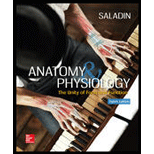
Cells of the ________ are keratinized and dead.
- a. papillary layer
- b. stratum spinosum
- c. stratum basale
- d. stratum corneum
- e. stratum granulosum
Introduction:
The main type of cells which make up the epidermis are Markel cells, keratinocytes, with melanocytes and Langerhans cells. The subdivision of layers of the skin is strata carneum, strata lucidum, stratum granulosum, and stratum spinosum and stratum basale.
Answer to Problem 1TYR
Correct answer: Option (d) stratum carneum.
Explanation of Solution
Rationale: This is the topmost layer, consists of dead cells that shed periodically and is progressively replaced by cells formed from the basal layer.
Option (a). Papillary layer. It is the upper most layer of the dermis. It intertwines with the rete ridges of the epidermis and is composed of fine and loosely arranged collagen fibres.
Option (b). Stratum spinosum. It is a layer of the epidermis found between the stratum granulosum and stratum basale.
Option(c).Stratum basale. It also contains melanocytes, cells that produce melanin, the pigment primarily responsible for giving skin its colour.
Option (e). Stratum granulosum. It is a thin layer of cells in the epidermis.
Stratum carneum is the top layer of the skin and it protects the living cells beneath it by providing a tough barrier between the environment and the lower layers of the skin.
Want to see more full solutions like this?
Chapter 6 Solutions
Anatomy & Physiology: The Unity of Form and Function
Additional Science Textbook Solutions
Biology Illinois Edition (Glencoe Science)
Human Anatomy & Physiology
Microbiology: An Introduction (13th Edition)
Genetics: Analysis and Principles
Laboratory Manual for Holes Human Anatomy & Physiology Fetal Pig Version
- As you are walking down the beach, you see a dead, dry, shriveled-up fish. Which layer of your epidermis keeps you from drying out? stratum corneum stratum basale stratum spinosum stratum granulosumarrow_forwardLangerhans cells are commonly found in the ________. stratum spinosum stratum corneum stratum granulosum stratum basalearrow_forwardThe papillary layer of the dermis is most closely associated with which layer of the epidermis? stratum spinosum stratum corneum stratum granulosum stratum basalearrow_forward
- The layer of the skin composed of dense connective tissue that has projections known as papillae is the ____________. A. stratum corneum B. stratum basale C. dermis D. hypodermisarrow_forwardFor questions 2–6, match the layer of the epidermis with the correctdescription or function:a. stratum basale d. stratum lucidumb. stratum corneum e. stratum spinosumc. stratum granulosum2. Production of keratin fibers; formation of lamellar bodies; limitedamount of cell division3. Sloughing occurs; 25 or more layers of dead squamous cells4. Production of cells; melanocytes produce and contribute melanin;hemidesmosomes present5. Production of keratohyalin granules; lamellar bodies release lipids;cells die6. Dispersion of keratohyalin around keratin fibers; layer appears transparent; cells deadarrow_forwardIn which layer of the epidermis do the nucleus and other organelles disintegrate and the cells die? A. Stratum granulosum B. Stratum basale C. Stratum lucidum D. Stratum corneumarrow_forward
- Which of the following associations is INCORRECT? A. Keratinocytes; found in the stratum spinosum B. Langerhans cells; immune cells C. Melanocytes; typically found in the stratum corneum D. Adipocytes; fat cells E. None of the abovearrow_forwardDescribe briefly the changes that occur in keratinocytes when they migrate from the stratum basale to the stratum corneum. How is the structure of the stratum corneum related with the main functions of the epidermis?arrow_forwardAs you are walking down the beach, you see a dead,dry, shriveled-up fish. Which layer of your epidermis keepsyou from drying out? a. stratum corneumb. stratum basalec. stratum spinosumd. stratum granulosumarrow_forward
- Basal cell carcinomas are the most common form of skin cancers in the United States and are frequently found on the head, neck, and arms. This cancer affects which cells? A. Langerhans cells of the stratum lucidum B. keratinocytes of the stratum spinosum C. melanocytes of the stratum basale D. basal cells of the stratum basalearrow_forwardThe following are the four (4) compartments of the epidermis, differentiate each. 1) the stratum basale, 2) the stratum spinosum, 3) the stratum granulosum, 4) the anucleated outermost layer, the stratum corneum,arrow_forwardConsists of one row of actively mitotic stem cells; some newly formed cells become part of the more superficial layers a stratum basale b stratum granulosum c stratum lucidum d stratum corneumarrow_forward
 Anatomy & PhysiologyBiologyISBN:9781938168130Author:Kelly A. Young, James A. Wise, Peter DeSaix, Dean H. Kruse, Brandon Poe, Eddie Johnson, Jody E. Johnson, Oksana Korol, J. Gordon Betts, Mark WomblePublisher:OpenStax College
Anatomy & PhysiologyBiologyISBN:9781938168130Author:Kelly A. Young, James A. Wise, Peter DeSaix, Dean H. Kruse, Brandon Poe, Eddie Johnson, Jody E. Johnson, Oksana Korol, J. Gordon Betts, Mark WomblePublisher:OpenStax College


